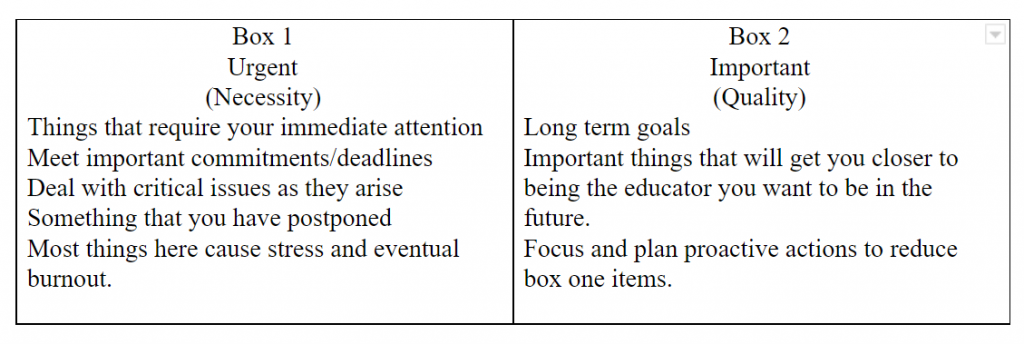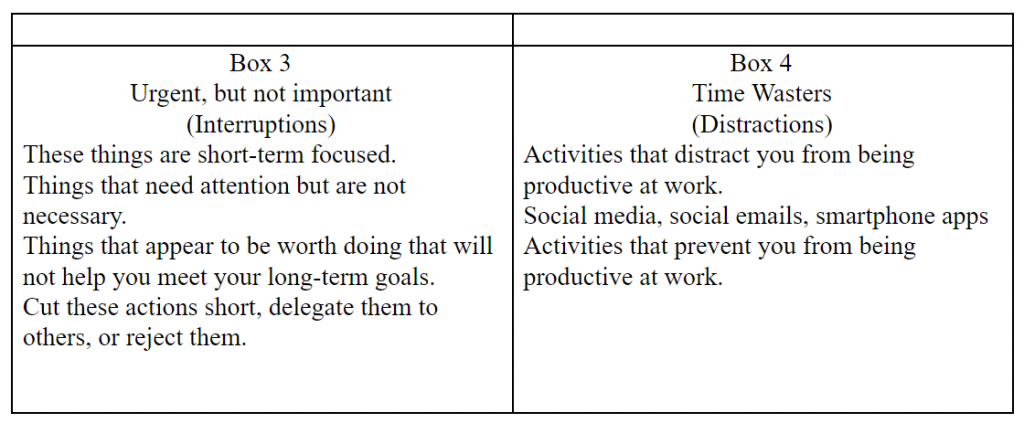
By James T. Lindroth, Ph.D., Northeastern State University
Time management can be a struggle for many people. There is not have enough time to get things done. Teachers feel this pressing time crunch more than ever because of the addition of accountability measures such as state testing and preparation, increased committee meetings, and faculty development projects added to their workday. This article aims to help educators become effective teachers by recognizing long-term goals for their classrooms and developing effective time management strategies. It is important to note that this article focuses on work-related activities and not personal/family priorities. However, the concepts and strategies in this article can be modified to include personal/family activities. In Stephen Covey’s 1994 groundbreaking book, 7 Habits for Highly Effective People, he developed a matrix to help people understand how they use their time, prioritize activities, and use time proactively. It is an easy system to understand and use for educators. Figure 1 outlines the updated matrix.


We spend our time at work in one of four ways, based on two factors that define an activity: urgent and important. Box 1 is activities or things that are urgent and require your immediate attention. Most of the things in this box cause stress because they deal with meeting deadlines/commitments, pressing problems, critical issues that arise in the classroom, and something you have postponed. These actions are urgent, but they may not be essential to your overall program or growth as a teacher. Many teachers spend most of their time here. They are always reacting rather than planning. Too much time in this box causes stress and burnout.
Box 2 deals with your vision and long-term goals. What kind of teacher do you want to be in the future? Where do you want your program to be in the future? Once you decide on your long-term goals, list activities that will bring you closer to that vision. These are the essential things you find most valuable. The issue with box 2 is that these things tend to be not urgent and can quickly become put on the back burner. The goal is to spend more time in this box, which requires proactive focus and planning to reduce as much time spent in Box 1.
Box 3 are things that need to be completed but are less/not important. In this box are things that are short-term focused and require you to react rather than be proactive. These things appear to be worth completing, but do not help you achieve your long-term goals. Many of the actions are nothing more than interruptions. Examples of these types of interruptions for educators may include emails and text messages, irrelevant meetings, fundraising, uniform fitting, unnecessary performance, etc. Cut short your use of emails and text messages during the day, reduce or say no to unnecessary performances and meetings, and learn to delegate. Many of the activities in this box could be handled by someone else, such as your boosters, student leaders, co-workers, etc. People who micro-manage too much struggle in this box because they feel the need to do everything and not trust others to complete the task.
Box 4 is all the activities that waste precious time. Today, we have more options to divert our time than ever before. Social media, internet browsing, online shopping, and smartphones tempt us to stray from the essential things we should be doing at work. These activities are time wasters. Too much time in box 1 dealing with urgencies and deadlines can cause high-stress levels that any free time we have is usually spent here in box 4 to forget about work. The goal is to avoid box 4 as much as possible.
Planning
Time is the most valuable resource. Once it is gone, you cannot get it back. Once you have placed all your activities into the four boxes, you can begin to plan. When planning, it is crucial to work from your calendar and not a to-do list. To-do lists only work in box 1; dealing with things is urgent. Organize your schedule on a weekly, bi-weekly, or monthly basis. If you organize daily, you are right back into box 1. The focus is to eliminate and manage your activities, so most of your planning will include your box 2 activities that are important to you. Remember, these are the actions that will bring you closer to achieving those long-term goals.
Journals and notebooks can also be a positive resource for identifying and developing long-term goals. Carry a notebook or use an e-notebook app to write down important ideas, teaching tips, or even thoughts that will help you reach your long-term goals in box 2. Go back and read through them often. Our minds are best used for processing ideas, not just storing information.
About the Author
Dr. James T. Lindroth received his B.M. in Music Education from the University of Lowell, his M.M. degree in Music Performance from the University of Massachusetts Lowell, and his Ph.D. in Music Education from the University of South Florida. His research interests include the construction of creative identity in music and pre-service teacher education. He has presented his research at local, state, and international conferences. Dr. Lindroth is an active clinician and adjudicator at the secondary level. He is a member of the Central States Judges Association, where he adjudicates marching bands and indoor percussion ensembles throughout the United States as well as local music festivals. He is also part of the Vic Firth and Zildjian Education Team. Dr. Lindroth proudly serves on the Scholarly Research and Health and Wellness Committees for the Percussive Arts Society (PAS). Dr. Lindroth is an active music scholar presenting his research at many national and international conferences, and his research has been published in various media periodicals and peer-reviewed journals such as UPDATE: Applications in Research in Music Education and Kansas Music Review.














